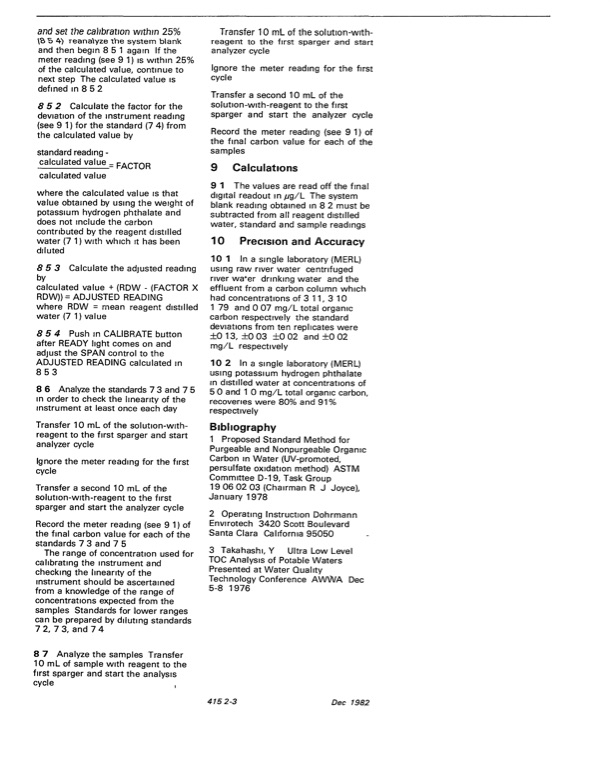
PDF Publication Title:
Text from PDF Page: 466
and set the calIbratIOn wlthm 25% \?> '5 4) reana\yze the system blank and then begm 85 1 agarn If the meter readrng (see 9 1) IS wIthin 25% of the calculated value, continue to next step The calculated value IS defined In 8 5 2 8 5 2 Calculate the factor for the deviation of the mstrument reading (see 9 1) for the standard (7 4) from the calculated value by standard readrng - calculated value - FACTOR calculated value where the calculated value IS that value obtained by uSing the weight of potassium hydrogen phthalate and does not rnclude the carbon contributed by the reagent dIstilled water (7 1) wIth which It has been dIluted 85 3 Calculate the adjusted reading by calculated value + (RDW - (FACTOR X RDW));::: ADJUSTED READING where RDW =mean reagent distilled water (7 1) value 8 5 4 Push In CALIBRATE button after READY light comes on and adjust the SPAN control to the ADJUSTED READING calculated In 853 8 6 Analyze the standards 7 3 and 7 5 rn order to check the linearity of the rnstrument at least once each day Transfer 10 mL of the solutlon-wIth- reagent to the first sparger and start analyzer cycle Ignore the meter readrng for the first cycle Transfer a second 10 mL of the solutIOn-wIth-reagent to the first sparger and start the analyzer cycle Record the meter readrng (see 9 1) of the frnal carbon value for each of the standards 73 and 7 5 The range of concentratIon used for callbratrng the rnstrument and checkrng the linearity of the Instrument should be ascertained from a knowledge of the ra nge of concentrations expected from the samples Standards for lower ranges can be prepared by diluting standards 7 2, 7 3, and 7 4 8 7 Analyze the samples Transfer 10 mL of sample with reagent to the first sparger and start the analysIs cycle Transfer 10 ml of the solutlon-wlth- reagent to the first sparger and start analyzer cycle Ignore the meter reading for the fIrst cycle Transfer a second 10 mL of the soJutlon-wlth-reagent to the fIrst sparger and start the analyzer cycle Record the meter readrng (see 9 1) of the frnal carbon value for each of the samples 9 Calculations 10 PrecIsion and Accuracy 10 1 In a single laboratory (MERL) usrng raw river water centrifuged river wa+er drlnkrng water and the effluent from a carbon column which had concentratIOns of 3 11, 3 10 1 79 and 0 07 mg/L total organIc carbon respectively the standard devIatIons from ten replicates were ±O13, ±O03 ±o02 and ±O02 mg/L respectively 10 2 In a single laboratory (MERL) uSing potassium hydrogen phthalate rn distilled water at concentrations of 50 and 1 0 mg/L total organIc carbon, recovenes were 80% and 91 % respectIvely Bibliography 1 Proposed Standard Method for Purgeable and Nonpurgeable OrganIc Carbon rn Water (UV-promoted, persulfate OXIdatIon method) ASTM Committee D-19, Task Group 19060203 (Chairman R J Joyce), January 1978 2 Operating InstructIOn Dohrmann Envlrotech 3420 Scott Boulevard Santa Clara California 95050 3 Takahashi, Y Ultra Low Level TOC AnalYSIS of Potable Waters Presented at Water Quality Technology Conference AWWA Dec 5-8 1976 The values are read off the frnal 9 1 digital readout In /lg/L The system blank readrng obtarned rn 8 2 must be subtracted from all reagent dIstilled water, standard and sample readrngs 4152-3 Dec 1982PDF Image | Methods for Chemical Analysis of Water and Wastes

PDF Search Title:
Methods for Chemical Analysis of Water and WastesOriginal File Name Searched:
epa600_4_79_020.pdfDIY PDF Search: Google It | Yahoo | Bing
CO2 Organic Rankine Cycle Experimenter Platform The supercritical CO2 phase change system is both a heat pump and organic rankine cycle which can be used for those purposes and as a supercritical extractor for advanced subcritical and supercritical extraction technology. Uses include producing nanoparticles, precious metal CO2 extraction, lithium battery recycling, and other applications... More Info
Heat Pumps CO2 ORC Heat Pump System Platform More Info
| CONTACT TEL: 608-238-6001 Email: greg@infinityturbine.com | RSS | AMP |